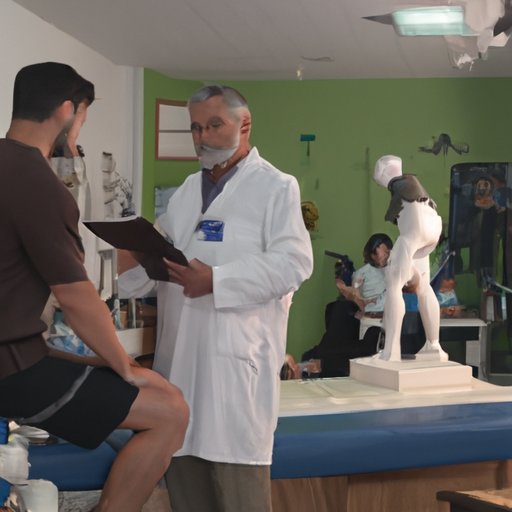
Introduction
Physical therapy is a rapidly growing field that plays a vital role in healthcare. Physical therapists work to help patients recover from injuries, surgeries, and illnesses by utilizing specialized techniques and exercises. If you are considering a career in physical therapy, this article will provide you with all the essential information you need to become a successful physical therapist.
5 Steps to Becoming a Successful Physical Therapist
Here are five simple steps to becoming a successful physical therapist:
Step 1: Research and Understand the Field of Physical Therapy
The first and essential step to becoming a physical therapist is to research and understand the field. You should read, attend seminars, and meet with experienced professionals to learn more about the profession. Understanding the physical therapy field will prepare you to make informed career choices, and you will be able to set realistic goals based on your strengths and interests.
Step 2: Get a Bachelor’s Degree in a Related Field of Study
The next step is to enroll in a bachelor’s degree program in a related field of study, such as biology, anatomy, or kinesiology. Coursework in physiology, chemistry, and physics can be beneficial, but it’s not required. However, a solid foundation in these subjects is essential to understanding the science behind physical therapy.
Step 3: Get a Doctor of Physical Therapy (DPT) Degree
To become a physical therapist, you need to get a Doctor of Physical Therapy (DPT) degree. DPT programs typically last three years and require a bachelor’s degree and prerequisites such as anatomy, physiology, and physics. Some programs may require additional experience, patient care hours, and other supplementary factors.
Step 4: Gain Practical Experience through Internships and Volunteering
Getting practical experience in physical therapy is one of the most critical steps to becoming a successful physical therapist. You can gain experience through internships, volunteering, and other opportunities. Practical experience will give you a chance to apply your knowledge, develop your skills, and build your network of contacts in the profession.
Step 5: Pass the National Physical Therapist Examination (NPTE)
After completing a DPT program and gaining practical experience, you will need to pass the National Physical Therapist Examination (NPTE) to become a licensed physical therapist. This test is administered by the Federation of State Boards of Physical Therapy (FSBPT) and assesses your understanding of physical therapy concepts and the ability to apply that knowledge effectively.

Educational and Professional Requirements for Physical Therapy
To become a physical therapist, you need to fulfill specific educational and professional requirements, including:
Educational Requirements
You must have a bachelor’s degree and a Doctor of Physical Therapy (DPT) degree to become a physical therapist. The DPT program typically takes three years. You must also pass the National Physical Therapy Examination (NPTE) to become licensed.
Professional Requirements
After becoming licensed, you must meet continuing education requirements to maintain licensure. It’s also essential to obtain certification in specialized physical therapy areas to expand career opportunities.
A Guide to Getting Licensed as a Physical Therapist
Here’s a step-by-step guide on how to get licensed as a physical therapist:
Step 1: Complete a Bachelor’s Degree
You must obtain a bachelor’s degree, focusing on coursework in the sciences, including anatomy, biology, physics, and physiology.
Step 2: Complete a Doctor of Physical Therapy (DPT) Program
The DPT program typically takes three years, and you must complete both classroom and clinical training.
Step 3: Obtain a License to Practice Physical Therapy
After completing a DPT program, you must pass the National Physical Therapy Examination (NPTE). Once you pass, you will be eligible for licensure in your state. Each state has its specific requirements, so you must check with the state licensing board for more information.
Step 4: Maintain Your Licensure
After obtaining a license, you will need to meet continuing education requirements to maintain your licensure. These requirements usually include taking courses, workshops, or other educational programs on physical therapy topics.
The Skills and Qualities You Need to Excel in the Field of Physical Therapy
Physical therapists need specific skills and attributes to excel in their profession, including:
Empathy
Physical therapists must show empathy towards their patients and put themselves in their patients’ shoes to understand their needs and emotions.
Communication Skills
Physical therapists must have excellent communication skills to explain complex medical terms to their patients and their families simply.
Problem-Solving
Physical therapists must use their expertise to identify the problem and create an appropriate treatment plan for their patients. They must also be able to adjust the plan to meet the patient’s evolving needs.
Breaking Down the Anatomy and Physiology Courses Essential for Aspiring Physical Therapists
Anatomy and physiology are essential courses for aspiring physical therapists. Understanding the human body’s structure and function is fundamental to create effective treatment plans. These courses will cover topics such as:
- The Skeletal System
- The Muscular System
- The Nervous System
- The Cardiovascular System
How to Gain Practical Experience before or during Physical Therapy Education
Gaining practical experience in physical therapy can help you to stand out as a candidate when applying for a job. Here are some tips on how to gain practical experience:
- Volunteer at a local hospital or rehab center
- Shadow a physical therapist
- Participate in research studies
- Join clubs or organizations related to physical therapy
- Get certified as a personal trainer or fitness instructor
The Path to Becoming a Specialist in a Specific Area of Physical Therapy
The field of physical therapy offers numerous areas of specialization, including:
- Orthopedic Physical Therapy
- Geriatric Physical Therapy
- Cardiopulmonary Physical Therapy
- Neurological Physical Therapy
To become a specialist in a particular area of physical therapy, you must take additional coursework or training to gain an in-depth understanding of that specialty.
Conclusion
Becoming a physical therapist is an excellent career choice for those interested in healthcare, helping others, and promoting wellness. While the process can be lengthy, the field is rewarding, and there are many opportunities for growth and development. We hope that this guide has provided you with the necessary information to pursue a career in physical therapy.
If you need further information on becoming a physical therapist, check with organizations such as the American Physical Therapy Association (APTA) or the Federation of State Boards of Physical Therapy (FSBPT).




